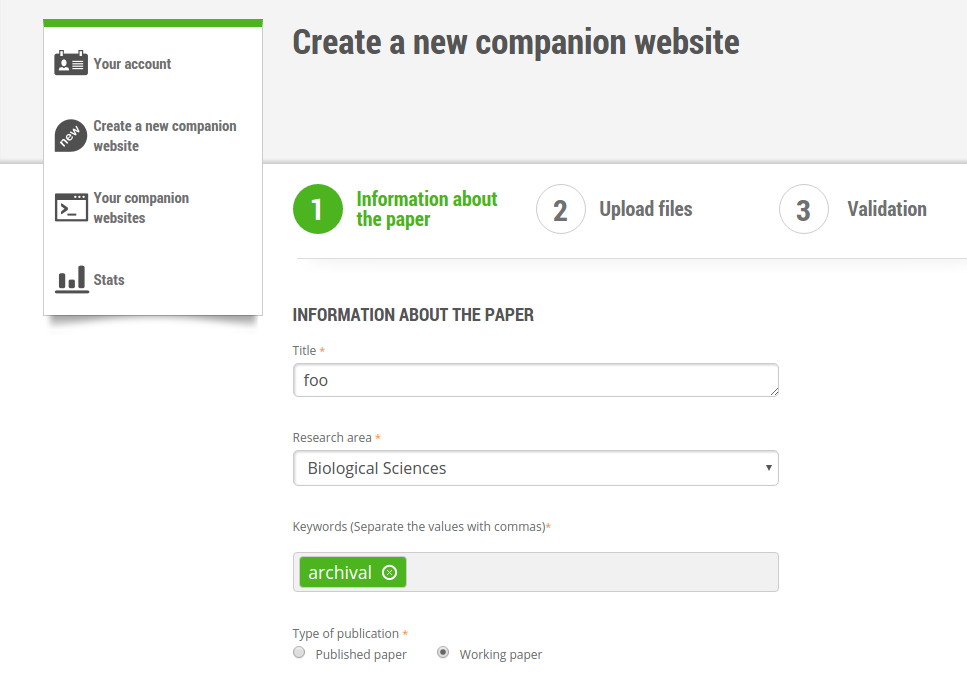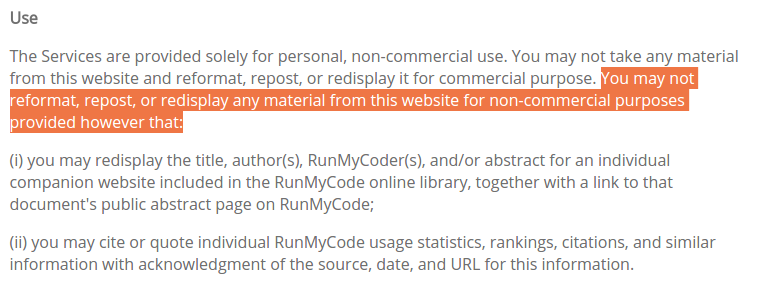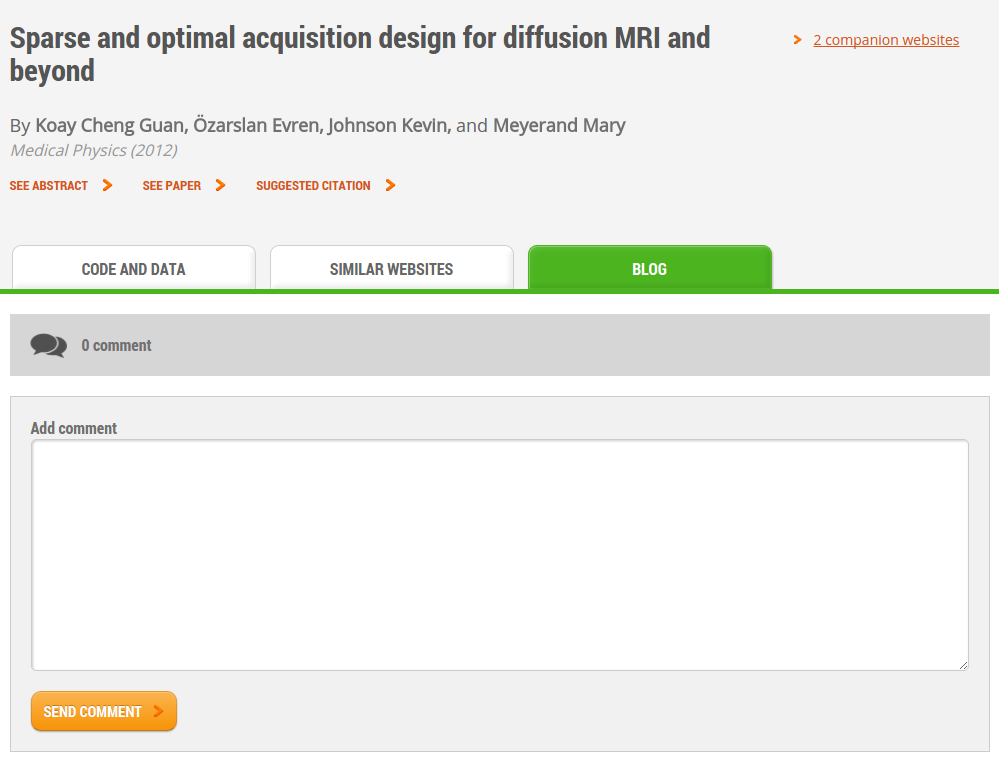About
Authors
Christophe Hurlin (University of Orleans)
Christophe Perignon (HEC Paris)
Victoria C. Stodden (Columbia University)
Information
Type: Metadata/File Hosting
License: Closed-Source
Timeline: 2013
Institution: RunMyCode Association
Links
Example Page - Has some Java code archived. Upon inspection, it is just the compiled binaries.
Motivation
From the RunMyCode website:
RunMyCode follows three main objectives:
- To allow researchers to quickly disseminate the results of their research. This will considerably increase the potential of citations of scientific papers.
- To provide a large community of users with the ability to use the latest scientific methods. This will speed up the process of converting scientific results into productive forces.
- To allow members of the academic community (researchers, editors, referees, etc.) to replicate scientific results and to demonstrate their robustness. This will increase transparency and trust in science.
Rubric
✔ - Yes
✗ - No
○ - Yes, but with concession
· - Inapplicable
? - Unknown
| Infrastructure | ||
| Self-Hosting | ✗ | Closed-source. Cannot replicate website or environment. |
| Provides Metadata | ✔ | Provides: creation date, programming language used, a citation, and an abstract/description. |
| Provides Hardware Diversity | ✗ | Provides no infrastructure. |
| Dispatches Work to Cloud Machines | ✗ | |
| Provides a Web Portal | ✔ | runmycode.org (however, it is not under HTTPS) |
| Provides Performance Monitoring | ✗ |
| Capabilities | ||
| Runs Code | ✗ | Does not run code. |
| File Storage | ✔ | Can upload 100MB worth of data. |
| Collaboration Controls | ✗ | No ability to collaborate through the website. Although there is a forum posting capability. (See discussion below) |
| Provides Citations | ✔ | Can manually provide a citation. |
| Interactive Graphing | ✗ | |
| Can Combine Objects | ✗ | |
| Can Archive/Run GUI Tools | ✗ | |
| Can Hook to External Services | ✗ |
| Access | ||
| Public view of object | ✔ | |
| Access Permissions for Editing | ✗ | There are no access control options for adding other accounts for read/write/review access. |
| Access Permissions for Reading | ✗ | |
| Access Permissions for Anon Review | ✗ |
| Provenance | ||
| Search | ✔ | Basic keyword/tag search. |
| Globally Unique Identifiers for Projects | ✗ | Only a local identifier in the URL. |
| Provides URL to Project / Data | ✔ | Example: (http://www.runmycode.org/companion/view/1532)[http://www.runmycode.org/companion/view/1532] |
| Governance | ||
| Open Source | ✗ | Closed-Source |
| Allows Modification / Redistribution | ✗ | |
| Has a Free-to-Use Package | ✔ | Public and free-to-use. |
| Has a Student Package | · | |
| Has a Paid Package | · |
Walkthrough
Once an account is created and someone is logged in, you can quickly create a companion website through a three-step process.
The first step is to enter in the metadata around your upload. The title and tags that categorize the work. You can also put in some citation information and a long-form abstract to describe the work.
In the second step, you upload your files (up to 100MB) and specify or upload a README document to explain how to use the materials your are uploading. You must specify the software that is within the uploaded materials. You must upload a file, but you may upload more than one.
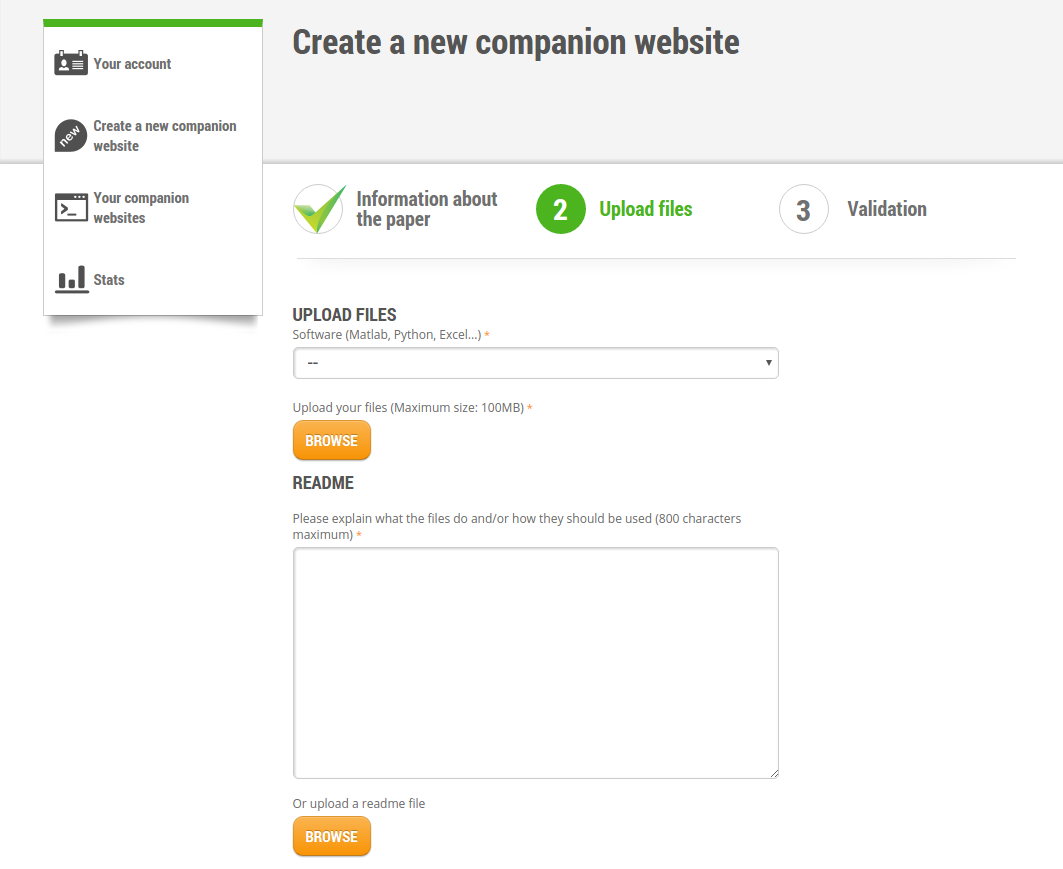
The browse button will upload and append a single file. You can add a zip file or a single large file up to 100MB.
In the third step, you must agree to the terms of service.
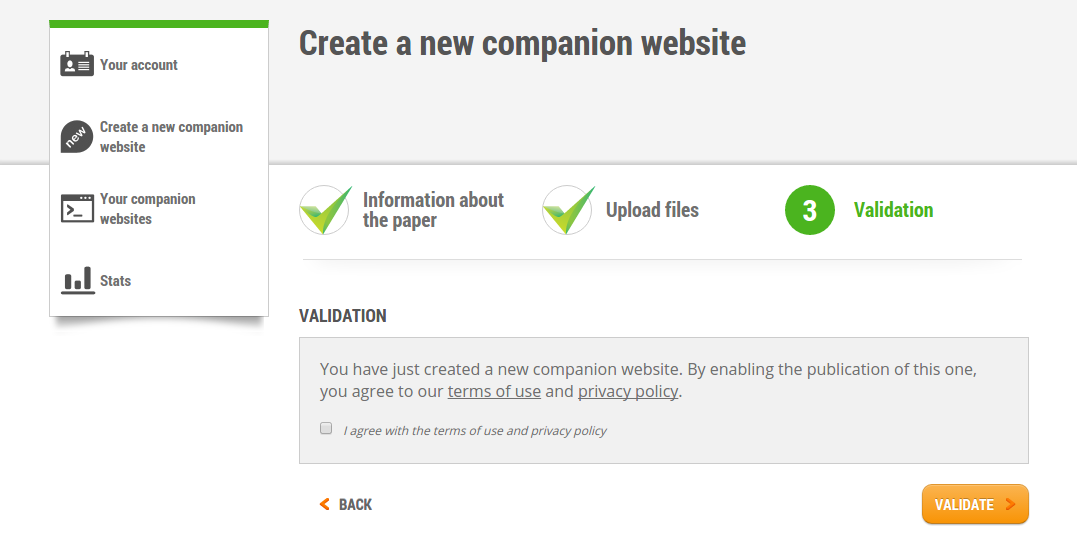
The terms of service dictate how the RunMyCode association restricts and uses content that is uploaded. You must agree to host files.
However, upon inspection of those usage terms, uploaded files give up their ability to be redistributed:
This may violate the license considerations for source code if uploaded to the site. Therefore, free-software or open-source code may not be uploaded to this service legally.
Also, the terms open the possibility that the materials may be removed for any reason:
Given that there is no process for contesting this process and no opportunity to self-host your materials, the longevity of the archive is in question.
Infrastructure
This is a centralized service that hosts file archives and small amounts of metadata. The service does not provide any computational capabilities nor does it run any code. It can support up to 100MB of uploaded files per companion website. No external service can be used to augment the storage capability of the archive.
Capabilities
The infrastructure hosts files up to 100MB. As a viewer, you can see the metadata and download the archive.
You can also add comments and participate in a public forum centered around each individual website. That way, any issues can be resolved either through the author responding to questions there, or from the community either answering questions or posting the issues and how they resolved them.
Access
Each project is tied to a particular account. There are no methods of adding others to see or edit a project's metadata. There is no ability to make an upload private. Therefore there is no method of exposing a private project anonymously for the purpose of artifact or paper review.
Provenance
There is no ability to add relationships to artifacts linking to other artifacts. The only exception is a citation that can point to a publication related to the artifact. There is a citation provided and dating of artifacts which can suggest the environment that the artifacts were created. The only other source of origin information is the provided space for a README or abstract and any user-generated comments.
Governance
The source code for this service is privately retained. As a closed-source project, there is no mechanism to enhance or reuse the code for this site. This speaks to longevity. The service, if abandoned, cannot be rehosted. Also, new features cannot be reintroduced by others outside of the current developers.
The service is free for all. There is no process for validating accounts. That is, it is not required to be a university student or researcher to participate in this community. There are no paid packages or pay-for-privilege opportunities. All accounts are equal.
Strengths
This is an easy to use service that will be very good for softer sciences to host their datasets and scripts.
Breakdown
- Easy
- Free-to-use
- Social Community Tools
Weaknesses
While great for some sciences, its simplicity may fail to account for the needs of more demanding computational experimentation.
This service does not run code nor does it provide any means of ensuring longevity of code. That is, the code that is uploaded may not be easily used and may break when new versions of libraries or tools are released.
Breakdown
- Cannot run code
- Does not archive dependent tools
- No private projects nor anonymous reviewer mode
Unique Features
To be discussed.
Best-Practice Influences
To be discussed.
Digital Library Incorporation Issues
To be discussed.
Applied Use-cases
To be discussed.

